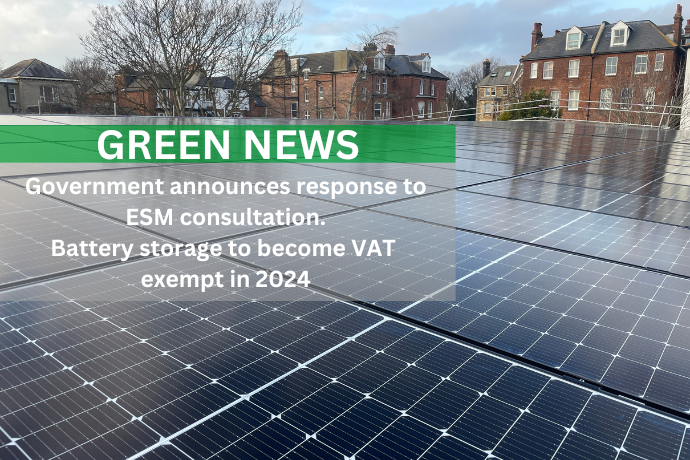Unit 1B, Keynor Farm
Sidlesham, PO20 7LL
8:30am - 5:00pm
Monday - 4:00pm Friday
Blog

Battery storage to be included in zero VAT scheme
The Government has released its response to a recent consultation on energy-saving materials (ESM’s).
In the Spring 2022 budget VAT relief was announced for some energy saving measures including solar PV and Ground and Air heat pumps.
Part of this scheme was battery storage when installed alongside one of the listed ESMs. Following a period of lobbying the government released a consultation on ESMs and the VAT relief for these. The aim of the consultation was to gather feedback from the industry about other products that should be considered to be included in the zero VAT scheme.
The Government received a large amount of feedback from the consultation, particularly with regards to storage.
How does battery storage work?
Battery storage is simply a way of storing surplus energy produced by a renewable energy source. Most commonly storage is use in conjunction with solar PV, this will form the basis of this blog.
When a solar array is producing more energy than a property is using this energy is exported to the national grid. Storage sits within the system to capture any un-used energy. When usage is higher than renewable generation power will be exported from the batteries rather than imported from the national grid.
There are 2 main ways of adding storage to a property with a solar array, AC Coupled or DC Coupled. Although very similar the equipment used, and some of the working parameters are different.
A key benefit of storage is its modular capability. This means you can easily have a smaller storage system for a domestic property, or a large system for commercial use.
Another benefit is the ability of some equipment to provide a UPS function. This is basically the ability for some circuits within a property to be fully powered just by the batteries should there be a power cut. Not all equipment has this function, and it isn’t a standard feature of battery systems, a common mis-conception. Having batteries installed also does not mean you are ‘Off-Grid’, the equipment used still needs to be grid tied, and must meet stringent testing to be allowed to perform in the way that it does.
The last major benefit of storage is the way it can be used to save money on your bills. A well designed and well set up storage system can save money on electricity bills by reducing the amount imported from the grid.
What will be included in the zero VAT scheme?
An extract from the Governments response to the consultation states:
‘The government recognises the integral role that electrical battery storage can play in reducing households’ reliance on the grid, both when retrofitted to a qualifying ESM and when used as a standalone technology connected to the grid.
This technology already qualifies for VAT relief when installed alongside a qualifying ESM, as it is ancillary to a zero-rated supply. The government agrees with respondents, though, that this technology meets all of the stated objectives for this VAT relief in its own right, and will therefore bring electrical battery storage within the scope of the relief. This means that the technology will now also qualify for VAT relief when either retrofitted to a qualifying ESM, or installed as a standalone technology connected to the grid.
The government hopes this reform will enable more consumers to retrofit electrical battery storage to existing ESMs, allowing households to maximise the efficiency of their solar panels, wind turbines, and water turbines.’
To simplify, VAT will not be charged on:
- Battery storage systems retrofitted to existing renewable energy systems
- Standalone battery storage systems ‘AC Coupled systems’
- Battery storage installed as part of a solar PV system. This is as per the original 2022 publication which includes the renewable energy itself e.g. Solar PV
It is worth noting that to qualify for the zero VAT these products must be installed by a qualified person. The standard rate of VAT still applies to the ‘sale only’ of battery storage systems, and components.
When will this scheme start?
The reduced VAT will come into force from February 1st 2024. These scheme will continue until March 31st 2027 when ESMs will revert back to 5% VAT.
We are awaiting a publication with the full details of the amendments to the zero VAT for ESMs scheme. This will outline and define the full scope that we are able to work with.
Taken from the summary in the consultation document the summary reads;
‘as a result of this CfE, the government will be making the following reforms to the VAT relief on the installation of qualifying ESMs.
The government will be expanding the relief by bringing the following technologies within scope:
- electrical battery storage
- water-source heat pumps
- diverters retrofitted to ESMs such as solar panels and wind turbines
The relief will also be extended to the installation of all qualifying ESMs in buildings used solely for a relevant charitable purpose and will continue to apply when these ESMs are installed in residential buildings.’
To read the full document including the comments around heat pumps and wind turbines please see here: https://www.gov.uk/government/consultations/vat-energy-saving-materials-relief-improving-energy-efficiency-and-reducing-carbon-emissions/outcome/summary-of-responses



